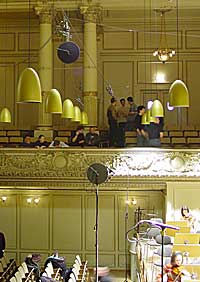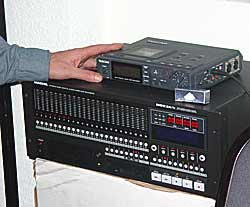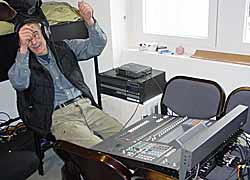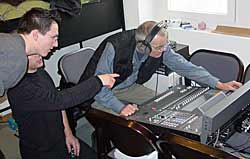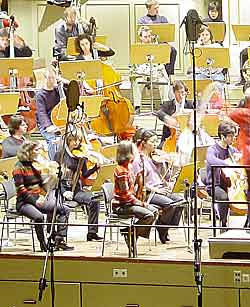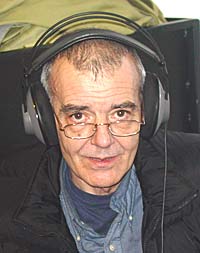1999 – 2012 avguide.ch gmbh switzerland
http://www.avguide.ch/magazin/sound-image-und-space-mehrkanalige-aufnahmetechnik
Sound, image and Space
Multi-channel recording technique
avguide visited during a recording sound engineer Jürg Jecklin at the Tonhalle in Zurich and learned the latest in the field of surround sound.
Behind the three words sound, image and space is concealed the secret of a good surround recording. avguide visited during a recording sound engineer Jürg Jecklin at the Tonhalle in Zurich and learned the latest in terms of good tone.
Problem child Surround Sound
Sky full of microphones: On the ceiling Jecklin stereo disc. On the stand: front-wheel for OSS 3-2-1 technology
In spring 2002, the Symphony Musikhochschule Winterthur Zurich, Zurich Tonhalle concert. Sound engineer Jürg Jecklin was mandated to implement them in a conventional CD stereo.Secretly, however, Jecklin used the opportunity to broaden his experience comes to surround sound.avguide Jürg Jecklin visited the control room and spoke with the inventor of Jecklin floats, as well as the legendary Transdyns Jecklinscheibe about his latest ideas in terms of multi-channel recording technique. One thing was quite clear: It takes far more than the largest possible number of microphones that is mixing it at will in some way on five channels to create the perfect surround sound.
The basic idea of the "OSS 3-2-1" technology
The Mackie 24-channel recorder HardDisk (below) works with high-resolution 24-bit and 96 kHz sampling frequency. Top: Stereo-DAT.
With OSS called 3-2-1 Jürg Jecklin his surround recording technology, the test phase is not yet complete. But the basic ideas are clear, and outlined the division of responsibilities for the different sound channels clear. In order to be understood internationally, makes use of the usual Jürg Jecklin in the film industry with respect to sound vocabularies. with "sound" is meant the sound quality. Possible that they should be good, of course. The term "image" refers to mapping of the direct sound, so for example the acoustic projection of an orchestra. The term "W" denotes the left-right figure. The depth map "Depth" is available in 5 layers:Layer 0 is where is the speaker level. Layer 1 specifies the normal distance, where you put a violin, place and listen to a singer. In layer 2 are such a small chamber orchestra, or the strings of a major symphony orchestra. positioned behind the strings, the brass sit in the third layer in the Layer 4, the back of the orchestra plazierzte percussion group and possibly shown a choir. Layer 5 is used to display remote orchestras, which are primarily perceived in space. "Space" is the space of a recording. A monophonic recording is no "space". In "Space", a distinction between front-Space, Side Space, Back Space and Full Space. A convincing surround recording can be done in full space. A stereo recording has only a front-Space. That would be like when you listen to a concert from a box. Side-space would be heard in a bad surround recording, in which the sound is only coming from left-right would. Backspace comes from behind. full space can be properly implemented only with 5 channels, but also mono sound. Image can be realized in stereo. With surround sound you have the advantage that you have the front three channels. This enables a defined center.
The time of the two-channel recording is over
Not satisfied with the sound?
Even stereo recordings should be done three channels. The situation has changed: Even with the mediocre sound surround re-administration of a 5-channel system-Kompakt result compared to a stereo playback advantages. The sound is of course better with an expensive speakers. But the full space is missing.
The question is: Will we get a better sound or full space? Space is often underestimated. We are continuously in an acoustic environment and are always there in a full space. The full-space, we have the time, he is the living room and not those of the concert hall or church. With a successful recording surround the relocation succeeds in the concert hall.
Of course, all speakers used should be sound quality. There is, however, the amount of two expensive high-end boxes for five good speakers, so you better than only two.
The world looks different now. Nevertheless, it goes with the surround sound on very resinous. The shops are still full of CDs and not full of music DVDs, or SACDs. The sound engineers and the industry to make only half-heartedly. Thus, the consumer is also only a very small range to choose from.
In the near future, one can assume that more and more people have a 5.1 system at home, but certainly not a second set next to it in stereo. The matter is arranged around the TV around. Now you have recordings of audio-amplifier and 5.1 speaker configuration are made. In Vienna, at the Institute of Acoustics and experimental music in all control rooms in the AV amplifier with small Tannoy monitors use. It must also be taken to avoid being played on such a system stereo recording sounds good. This is now, for example, Dolby Pro Logic 2 is a very good playback capability.
Distribution of tasks
Jürg Jecklin with two students
Looking at the matter from the video-film side, has one of the five channels in the broad sense "Sound, Image and Space". The center channel takes over the dialogue. Front left and front right are for the voice-over (technical term from the film industry) is used, so for sound generator, which are located forward, but not in the picture. The rear channels produce background noise. The .1 channel plays only in the low frequency Keller called "low frequency effects". This division of work is convincing and accepted by consumers.
Even with Jecklins OSS 3-2-1 technology, there is a very similar distribution of tasks.Instead of dialogue would be the soloist, and instead of off-the orchestra sound. These two pieces of information are recorded separately and a strict Verkoppelung would be disastrous. Reason: The left-right balance can always adjust quickly, so even a layman.But the optimal balance between left / right and center, is very difficult to find. It must be assumed that the center speaker a bit louder, some quieter times. So you have to take an image insensitive to differences in the level of the center channel. This is the case, if something else entirely present on the center channel sound, as on the left-right channels. If the soloist So from left-right separated, you can select it louder or quieter without the sound collapses into itself.
In other words: can one needs to vary with the center channel volume without having to do the voiceover something. This is the movie soundtrack with dialogue in the center channel of the case. For music, it is more difficult because it is hardly possible to separate completely the soloist. If it louder in the wake of the center channel makes the whole spatial relationships change. Now comes the task of distributing OSS 3-2-1 technology with Image (3) Space (2) and Low Frequency Effect (1) for the course.
Miking
Two discs for optimum surround sound
For the voice-over sets up a Jecklin his discs with two ball microphones.
A mounted in the middle of super-cardioid microphone takes the information for the center channel. This allows the center channel may be varied in level, without at the image of the off-tone remains the same. It is possible, a soloist in the middle pull approach, and the sound of the orchestra remains untouched. Would be in the center channel to the soloist even as the wind section of the orchestra positioned behind it, would produce a level of variation, a drastic change, possibly even a collapse of the overall sound quality.Additional microphones may therefore only be assigned to the voiceover.
The thing with the Space
Incur from the rear must be a ghostly impression of space, so a virtual reality from a different room. The reality has gespenstigste one with an artificial head, at least in terms of space. You must now use a simulation method. What comes from the front, immediately locates it in the image. What appears on the mandatory side, one feels as a space. After Jecklins should view the area behind the side effect of producing non-speakers, but the listener will be drawn up. The whole should also work in the traditional 5.1 speaker arrangement.
Jecklin now uses the space for a second disc, the microphones are directed to the back and kidneys characteristic. This is because, the space signal can not contain direct sound components. Two omni would still first the direct sound from the orchestra, before arriving reflections would. Consequently Jecklin is now two kidneys in parallel and separated by a moderate intensity of this disc. Thus, only the rear half-space is taken up, the orchestra will disappear completely.
Final Thoughts
What is lacking at the moment, a Surround recording technique, which generally convinced. Now there are certain points not so good and unfortunately many good shots.Each experiment and see what the other does. On the Jecklin developed by Jurg OSS-3-2-1-recording technique is reported in avguide further. The plan is a blueprint for even a surround recording kit, which can also be used by the amateur with great success. One thing is certain: Jürg Jecklin has caused with his stereophonic Jecklin disc a sensation.The time for a surround configuration is right.
Sound engineer Jürg Jecklin
[size=14.166666030883789px]
- Worked 30 years at Radio DRS, including 10 years as chief engineer. In addition, [/size][size=14.166666030883789px][/size]
[size=14.166666030883789px]
freelance work for the record industry. - For his work as a sound engineer, he developed the electrostatic headphones Jecklin FLOAT, the OSS technique with the so-called Jecklin disc, and the sound processor TRANSDYN. - During nine years he was technical advisor to the company MB in Obrigheim (D) and taught for 15 years at the Music Academy of Basel, acoustics and "work with denMedien" - teaching in-service training for sound engineers of ZNM and the ZEPRA - Published approximately 400 articles in various national and international journals 3 Books: the Speaker Book, music recordings, mono-stereo Quadro to work. recording and playback of music - Current Job: Professor at the University of Music and Performing Arts Vienna, Institute for the Theory of sound. . Director of the Institute for Electroacoustics and Experimental Music (3 or professors, 4 assistants, 39 lecturers and 150 studentsCurrent developments: Kleinmonitorbox, professional headphones, methods for objective quality assessment of loudspeakers - Residence: primary residence 7603 Vicosoprano, a second home in Vienna - Email Address : floatsound@cs.com[/size]

























 .
.

